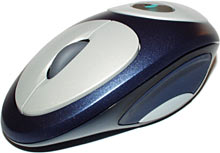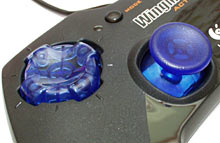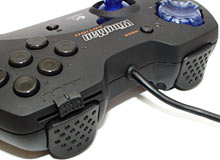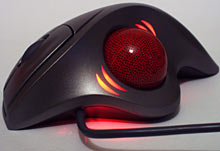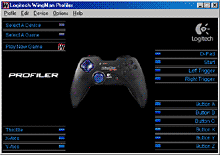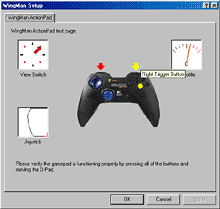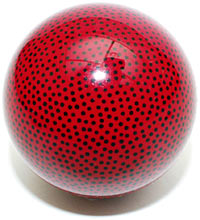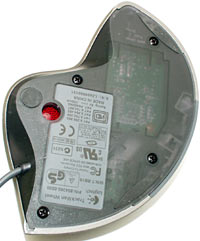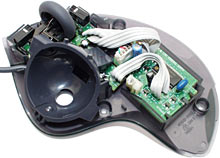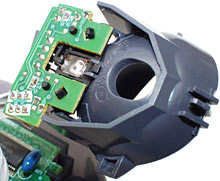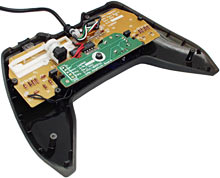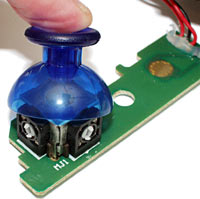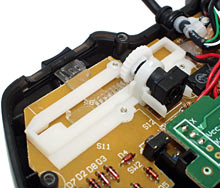
Logitech TrackMan Wheel trackball and WingMan Action Gamepad
Review date: 2 August 2001.Last modified 03-Dec-2011.
You used to know where you were with computer pointer-control devices.
Most of them were mouses, and they generally looked like mildly streamlined bricks with a couple of buttons stuck on 'em.
They were symmetrical, they weren't very comfortable, they pretty much did the job.
Particularly if your description of "the job" included "attracting every crud molecule for miles around and adding it to a filthy O-ring around each roller".
Trackballs have existed for ages, too. A trackball is, after all, essentially just a normal ball-type mouse lying on its back. And they used to be pretty straightforward too.
Some of them had a huge ball you could play pool with, some of them had a weeny little practically unusable plastic BB instead, which made them small enough to be built into laptops. But they still showed no sign that they'd fallen out of the Tree Of Funkitude and hit any branches on the way down.
Nowadays, though, we've got things like this.
This is Logitech's TrackMan Wheel, and it's a mid-range model in their current range of optical trackballs. It shares a certain designed-by-aliens look with other current Logitech products...
...like the Cordless MouseMan Optical, which I review here, by the way.
The TrackMan Wheel is not big and chunky. Its total nose-to-tail length is a little more than 140mm (5.5 inches), and the speckly red ball is 34mm (1.34 inches) in diameter. It has the normal complement of buttons that you get on every wheelie-mouse these days - left button, right button, scroll wheel that you can click for middle button functions. And it is not uncomfortable.
Well, as long as you're right handed, that is.
The TrackMan Wheel's asymmetric design puts the trackball under the thumb of your right hand, or almost uselessly under the little finger of your left. So all of you sinister mutants will just have to use something else.
Along with the TrackMan Wheel, Logitech were good enough to send me their WingMan Action Gamepad.
If you base your game controller purchase decisions solely on the number of knobs and buttons provided, the WingMan Action looks like a great choice.
It's got an eight-way D-pad controller, an analogue joystick...
...six thumb buttons plus a Start button...
...two "shoulder" trigger buttons, a throttle slider, and a Mode button as well.
Neither of these gadgets costs a fortune. The Australian recommended retail prices for the TrackMan Wheel and WingMan Action are $AU109 and $AU54, respectively. The US prices, at the Logitech online store at least, are $US39.95 and $US19.95, respectively.
This makes the TrackMan Wheel expensive, by mouse standards, but not ridiculously so. By trackball standards, it's not too pricey. You can get trackballs with less respected brands for half the price of the TrackMan, but other name-brand products like the Microsoft Trackball Optical - which looks rather similar to the TrackMan Wheel - cost about the same.
The WingMan Action, similarly, is more expensive than various off-brand game pads. But they're not likely to give you as many features.
Setting up
Both of these gadgets are USB devices, natively, and will be detected by the catch-all USB Human Interface Device driver if you just plug 'em in without installing any special software. In this mode, the TrackMan Wheel will behave as a normal wheelie-mouse as far as the computer's concerned, but you won't get full functionality out of the WingMan Action.
The TrackMan Wheel also comes with a PS/2 plug adapter, which lets you connect it to any PC with a PS/2 mouse socket. It will, again, Just Work if you do that, but you won't have any fancy configurability unless you're running extra mouse driver software.
The WingMan Action is USB only. There's no way to connect it to an old-fashioned joystick port.
Whichever way you plug the TrackMan Wheel in, it'll obey the Fancy Pointing Devices Union rule that states that all such gadgets must have superfluous LEDs built in that cause the device to glow in a sexy way. The curvy glow-slots on either side of the TrackMan's ball have no function; the ball tracking mechanism doesn't use these lights at all. But it looks cool.
Naturally, the TrackMan Wheel comes with Logitech's standard MouseWare package on an accompanying CD, which lets you customise the button action and wheel behaviour and so on. It also lets you use Logitech's slightly gimmicky "WebWheel" feature, to do Web navigation tasks with the wheel.
In USB mode, the TrackMan Wheel's got the standard snappy 125Hz refresh rate - the pointer position's sampled 125 times per second. So it's more than acceptable as a game controller, if of course you can get your head around controlling your games with a ball rather than a mouse. If you frequent crowded LAN parties, that might be a useful skill to develop.
One way or another, you can get the TrackMan Wheel working on Windows 95, 98, ME, NT and 2000. It'll also work on Mac OS 8.6 or higher, provided you've got a Mac with USB ports.
The TrackMan Wheel's support software is optional. The WingMan Action's support software is not. If you want to use the game pad properly, you have to install the utilities it comes with.
This is the WingMan Profiler, which allows you to set up separate control map profiles for all of your games. You can make all of the game pad's controls do different things, or do nothing at all.
There's a big list of "stock" game settings available, including quite a lot of games which I really don't think are suited to this sort of gadget at all. I suppose that if you were trying to think of a way to make Daikatana even worse, controlling it with a little joystick would do the trick. But what the heck. The more the merrier.
You can start with a stock setting and then customise it, or you can create game profiles from scratch. You can bind any button to pretty much any function, including a "shift" function that modifies the behaviour of other buttons. And you can attach macros to buttons, too; a single button-press doesn't have to equal just one normal key-press.
With six right-thumb buttons and two index-finger ones on the WingMan Action, you ought to be able to get any console port or MAME-emulated arcade classic working to your liking.
While you're playing, the WingMan Action's Mode button swaps the function of the analogue stick and the D-pad. In most games you won't want to do that - you'll want, for instance, to just use the stick to control your plane and the D-pad to change your cockpit view. But if you want to alternate, you can.
The WingMan Action software package also gives you this setup program. It lets you easily check the function of all of the controls, no matter what they're bound to in your game profiles.
Ergonomics
When I used the TrackMan Wheel, I found it awkward and weird.
The reason for that is not that the TrackMan Wheel is a lousy trackball; it's that I'm not used to using a trackball.
Some trackballs are designed for durability, tininess or groovy looks above functionality, but the TrackMan Wheel is not one of them. It's well laid out, and it's about as easy to use, for a right-hander like me, as any trackball's likely to be. It's not the wrong size for anybody whose hands aren't gigantic or minuscule, it doesn't assume you've got seven fingers, and you don't have to use both hands.
But it is, of course, very different from using a mouse. Just switching from one kind of mouse to a different-shaped one can be tricky enough for a few hours; switching to a trackball requires a whole new set of muscle memories to be developed, and you can't help but be clumsy for a while.
Get the hang of a comfy trackball like the TrackMan Wheel, though, and you've got a pointing device that takes up much less space than a mousemat, doesn't even need a level surface, can never "run out of mat", and gives you all of the precision you get from a mouse, too. Well, as long as your right thumb doesn't have fine motor coordination problems, anyway.
So there is definitely reason to learn.
Some very serious tasks, of course, are just made for a trackball. You can't play Centipede or Marble Madness properly with anything else. OK, I finished Marble Madness on the Amiga using a mouse, but it just wasn't right.
The ergonomics of the WingMan Action are pretty good, too. It's not one of those cramped game pads made for children; my normal-sized hands easily reach all of the controls on the game pad, and the gently curved handholds should let pretty much anybody use the thing comfortably enough.
On the down side, the WingMan Action uses basic dome switches for all of its digital controls, which means it feels a bit cheap. None of the buttons have a very positive tactile click, and the throttle slider's a bit wobbly too. The analogue joystick feels quite nice, though; it's not as good as the analogue sticks on Nintendo or Sony game console controllers, but it's not much worse.
As with the analogue sticks on other console controllers, you don't really get pin-point precision from the little stick on the WingMan Action's. It also has a quite strong centering mechanism, for its size - which is another common feature of game pad joysticks. So the WingMan Action isn't well suited to flight simulators or anything else where you want really fine control. But as an action game thumb-stick, it's fine.
Looking inside
Both of these products have some interesting features that you can't see without taking 'em apart. So I did.
It's easy to remove the ball from the TrackMan Wheel; it's retained by the rim of the housing so it can't just fall out, but there's a hole in the bottom of the housing that lets you prod it loose.
The speckly look of the ball is essential to the way in which the TrackMan Wheel works. It's an optical device, like the ball-less mouses that are so popular today.
Modern no-ball mouses have a tiny camera peering at the surface beneath the mouse, figuring out how that surface seems to be moving, and generating mouse movement signals accordingly. Optical trackballs like the TrackMan Wheel have similar hardware, but point their camera at a ball with a distinctively printed surface. So there are no rollers to gunk up or bearings to wear out. The ball support assembly contains a couple of tiny metal ball bearings that have to be there for the ball to rotate smoothly; they might, perhaps, gunge up over time. And, in time, you might be able to get enough dust and crud on the camera window that it needed cleaning. But that ought to be about it for maintenance.
The bottom of the TrackMan Wheel is translucent to let the red glow out, but you can't really see inside.
It's easy enough to take the thing apart, and inside it looks like nothing so much as a rearranged optical wheelie-mouse. Which is, after all, pretty much what it is.
This is the bottom of the ball assembly, with the ball removed. A couple of infra-red LEDs illuminate the tracked portion of the ball diagonally, and the camera peers out through a tinted window. If you take the ball out of the TrackMan Wheel while it's still plugged in, the camera may see all sorts of confusing things - the one I got for review likes to scoot the cursor to the top of the screen when it doesn't have its ball.
The WingMan Action has some twiddly bits of its own.
Here's the analogue stick assembly. It's based, like most ordinary two-axis joysticks, on a pair of potentiometers - variable resistors. In this case, the pots and the return spring assembly are all one compact little block.
The throttle mechanism doesn't use the linear potentiometer you might think it'd have. Instead, there's a rotary pot with a pinion gear on it, and it's turned by a toothed plastic rack attached to the throttle control.
The two shoulder buttons in the game pad are a cheap and simple design - they just have plastic prodding-sticks that push a couple of switch modules mounted on one of the game pad circuit boards, at right angles to the usual alignment. Many shoulder button designs put the switch mechanism right there next to the button. These ones don't, which reduces the amount of wiring and separate parts the game pad needs.
Overall
I like the TrackMan Wheel, even though I'm still lousy at using it, compared with my mouse. I haven't put in the hours to get fast at it. If I did, I'd be fine.
So if you want a trackball that's not terrifyingly expensive and has the normal wheelie-mouse button set, this looks like a great choice. Unless, once again, you're left handed. The TrackMan Wheel gets "Recommended" status from me.
I, personally, don't have much use for the WingMan Action, because the few games I'm playing at the moment are all mouse controlled. But if you're looking for a decent general purpose PC game pad with OK ergonomics, a reasonable price and a fair chance of not dropping dead after the first two nights of punishment, the WingMan Action deserves consideration. There are tons of PC game pads out there that cost less, but this one's got a full suite of controls, good support software and acceptable build quality for the money.
The WingMan Action doesn't quite make it as a "Recommended" product, though, because of its somewhat cheesy feel. It doesn't feel like junk (and you'd better believe that quite a lot of cheap game pads do), but neither does it feel great compared with the big-brand console controllers.
Check it out, and see what you think.
TrackMan Wheel and WingMan Action Gamepad kindly provided by Logitech.

